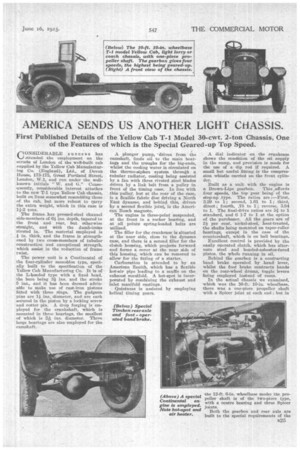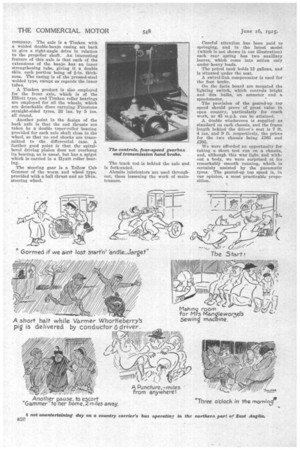AMERICA SENDS US ANOTHER LIGHT CHASSIS.
Page 9

Page 10

If you've noticed an error in this article please click here to report it so we can fix it.
First Published Details of the Yellow Cab T-1 Model 30-cwt. 2-ton Chassis, One of the Features of which is the Special Geared-up Top Speed.
GONSIDERABLE success has attended the employment on the streets of London of the well-'built cab supplied by the Yellow Cab Manufacturing Co. (England), Ltd., of Devon House, 173-175, Great Portland Street, London, W.1, and run under the wellknown initials "W. and G." Consequently, considerable interest attaches to the new T-1 type Yellow Cab chassis, built on lines somewhat resembling those of the cab, but more robust to carry the extra weight, which in this case is 11-2 tons.
The frame has pressed-steel channel side-members of 6i ins, depth, tapered to the front and rear, but otherwise straight, and with the dumb-irons riveted in. The material employed is f in. thick, and the frame is strengthened by two cross-members of tubular construction and exceptional strength, which assist in the reduction of frame twist.
The power unit is a Continental of the four-e3dinder monobloc type, specially built to the specification of the Yellow Cab Manufacturing Co. It is of the L-hcaded type with a fixed head, the bore being 31 ins, and the stroke 5 ins., and it has been deemed advisable to make use of cast-iron pistons fitted with three rings. The gudgeon pins are 1i ins, diameter, and are each secured in the piston by a locking screw and cotter pin. A drop forging is employed for the crankshaft, which is mounted in three bearings, the smallest of which is 211 ins. diameter. Three large bearings are also employed for the camshaft.
A plunger pump, 'driven from the camshaft, feeds oil to the main bearings and the troughs for the big-ends, whilst the cooling water is circulated on the thermossiphon system through a tubular radiator, cooling being amisted by a fan with three riveted steel blades driven by a link belt from a pulley in front of the timing ease. In line with this pulley, but at the rear of the case, is a flexible fabric disc driving a North East dynamo, and behind this, driven by a second flexible joint,. is the American Bosch magneto.
The engine is three-point suspended, at the front in a rocker bearing, and at all points spring-loaded bolts are tatilized.
The filler for the crankcase is situated at the near side, close to the dynamo case, and there is a second filler for the clutch housing, which projects forward and forms a cover at the near side of this housing, which can be removed to allow for the fitting of a starter.
Carburation is attended to by an American Zenith, which has a flexible hot-air pipe leading to a muffle on the exhaust manifold. A hot-spot is incorporated by combining the exhaust and inlet manifold castings.
Quietness is assisted by employing helical timing gears. A dial indicator on the crankcase shows the condition of the oil supply in the sump, and .provision is made for the use of a dip rod if required. A small but useful fitting is the compression whistle carried on the front cylinder.
Built as a unit with the engine is a Brown-Lips gearbox. This affords four speeds, the top gear being of the step-up ,type. The ratios are :—First, 3.29 to 1; second, 1.61 to 1; third, direct ; fourth, .78 to 1; reverse, 3.94 to 1. The final-drive ratios are 51 to 1 standard, and 6 1-7 to 1 at the option of the purchaser. All the gears are of 3,1 per cent. nickel-steel, heat-treated, the shafts being mounted on taper-roller bearings, except in the case of the countershaft, which is on ball bearings, Excellent control is provided by the easily operated clutch, which has alternate steel and bonded-asbestos-faced plates, the whole running in oil.
Behind the gearbox is a contracting band brake operated by hand lever, whilst the foot brake contracts bands on the rear-wheel drums, toggle levers being employed instead of cams.
In the actual chassis we examined, which was the 10-ft. 10-in, wheelbase, there was a one-piece propeller shaft with a Spicer joint at each end ; but in company. The axle is a Timken with a welded double-banjo casing set back to give a right-angle drive in relation to the propeller shaft. An interesting feature of this axle is that each of the extensions of the banjo has an inner strengthening tube, giving it a double skin, each portion being of fin. thickness. The casing is of the pressed-steel welded type, except as regards the inner tubes.
A Timken product is also employed for the front axle, which is of the Elliott type, and Timken roller bearings are employed for all the wheels, which are detachable discs carrying Firestone straight-sided tyres, 33 ins. by 5 ins. all round.
Another point in the design of the back axle is that the end thrusts are taken by a double taper-roller bearing provided for each axle shaft close to the wheel, so that no end shocks are transmitted to the differential case. A further good point is that the spiralbevel driving pinion does not overhang its bearing, as is usual, but has a spigot which is carried in a Hyatt roller bearing.
The steering gear is a Yellow Cab Gemmer of the worm and wheel type, provided with a ball thrust and an 18-in. steering wheel. The track rod is behind the axle and is fork-ended.
Alemite lubricators are used throughout, these lessening the work of maintenance. Careful attention has been paid to springing, and in the latest model (which is not shown in our illustration) each rear spring has two auxiliary leaves, which come into action only under heavy loads.
The petrol tank holds 13 gallons, and is situated under the seat.
A swivel-link compensator is used for the foot brake.
On the facia board are mounted the lighting switch, which controls bright and dim bulbs, an ammeter and a speedometer.
The provision of the geared-up top speed should prove of great value in open country, particularly for coach work, as 45 m.p.h. can be attained.
A double windscreen is supplied as standard on each chassis, and the frame length behind the driver's seat is 7 ft. 4 ins. and 9 ft. respectively, the prices for the two chassis being £365 and £395.
We were afforded an opportunity for taking a short test run on a chassis, and, although this was light and without a body, we were surprised at its remarkably smooth running, whichis certainly assisted by the pneumatic tyres. The geared-up top speed is, in our opinion, a most practicable proposition.






























